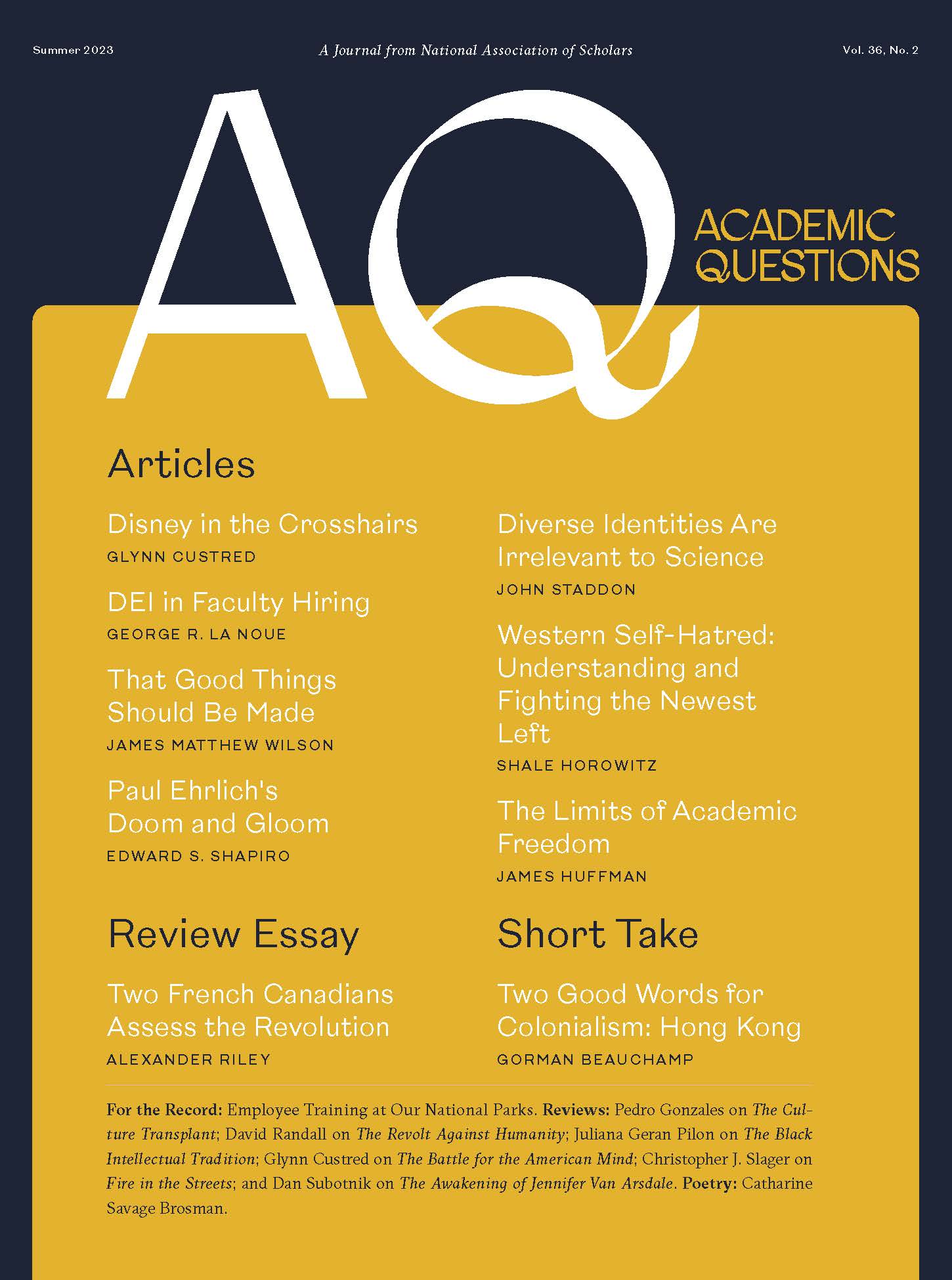The Revolt Against Humanity: Imagining a Future Without Us, Adam Kirsch, Columbia Global Reports, 2023, pp. 100, $15.19 paperback.
Adam Kirsch’s The Revolt Against Humanity seeks to alert a humanist audience to what he takes to be rising dangers: the twin, complementary movements of antihumanism and transhumanism. These movements both seek to displace man from the center of our moral universe, and Kirsch warns that they promise to capture the vanguard class of secular modernity.
Kirsch takes the intellectual presuppositions of these new movements too seriously, but he makes a good case that we should fear the power of these beliefs to attract our decadent elites.
Antihumanists have split off from the previous generation of environmentalists to adopt a belief indifferent to, or positively welcoming of, human extinction: “Anthropocene antihumanism offers a much more radical response to a much deeper ecological crisis. It says that our self-destruction is now inevitable, and what’s more significant, that we should welcome it as a sentence we have justly passed on ourselves.” (11) No longer conservationists who wish to preserve the environment for human use, or even environmentalists who wish to preserve the environment for its own sake but also seek mankind’s continuance, they now believe that mankind is separate from the environment, a cancer that inevitably yokes and deracinates all nature. The antihumanists now work to preserve the environment, indifferent, at best, to the survival of mankind or, ever more frequently, positively hostile.
Only by exterminating humanity can we express the disinterested moral concern that we profess to be the highest human ideal. “The death of the human species is the most life-affirming event that could liberate the natural world from oppression,” Patricia MacCormack writes, and it’s hard to see how other Anthropocene antihumanists could disagree. (43)
The antihumanists’ complements are the transhumanists, who wish to supersede humanity—to genetically engineer ourselves, to merge as cyborgs with artificial intelligence, en route to disposing of what humanity has been. They dream of a techno-utopia, in which man cannot partake, although he can create children who can.
Philosophically inclined transhumanists like to quote the Oration of Giovanni Pico della Mirandola as a precedent for their view that the only thing permanent about us is our need to change. There is no static human nature to which we can appeal in an attempt to halt technological progress in its tracks. On the contrary, in transcending Homo sapiens we are actually preserving the most authentically human thing about us. (65)
Transhumanists and antihumanists differ most sharply in the value they ascribe to consciousness: “Antihumanists believe that the universe doesn’t need to include consciousness for its existence to be meaningful. . . . Transhumanists, by contrast, believe the universe would be meaningless without minds to experience and understand it.” (82)
Whether or not we actually face environmental apocalypse or superhumanly brilliant artificial intelligence, Kirsch believes that the secularist vanguard class may well adopt some combination of antihumanism and transhumanism: “This class is already prone to believe that their superior rationality makes them better stewards and more responsible citizens. . . . They are the natural constituency for a biopolitics of limit and transformation that cuts across conventional political distinctions.” (94) The overlapping classes of the religious and the deplorables can oppose these beliefs with “the wisdom of repugnance,” but not with persuasive rational argument: “The wisdom of repugnance means that reason falls silent when it most needs to be heard.” (60) Transhumanism and antihumanism ought to be opposed, but Kirsch evinces no faith that they will be in any effective manner.
These movements may be intellectually aligned in their rejection of man, but they are emotionally disparate. Antihumanism grounds itself on environmentalist despair, and disgust at the thought of a deracinated nature, transhumanism on a combination of fear and delight. If we do face an unsolvable environmental apocalypse, or a killer supercomputer which cannot be defeated by an off switch, then we will indeed have cause for despair or fear—though if we cease to exist, we will also cease to despair or fear. But while the apocalypse tarries, it is difficult to maintain oneself indefinitely in a pitch of despair, disgust, or fear. I suspect that these aspects of antihumanism and transhumanism are too emotionally exhausting to endure more than a generation or two.
Antihumanism in particular can still do great damage. Communism ultimately collapsed in the Soviet Union, but its adherents killed tens of millions of their subjects and left enduring scars in the culture and psyche of the former Soviet realm. The radical environmentalists, now edging toward soft antihumanism, possess vast propaganda powers in the education complex, and growing numbers of personnel in our federal regulatory bodies. Their grandchildren may no longer believe their cult of despair, but here and now, we must oppose their policies and their beliefs.
Yet transhumanism’s offer of delight is a greater challenge in the long run. The joys of cyborg consciousness and life extension may indeed be greater than any happiness in human experience. This might just be a matter of temperament: some of us would prefer to have our brainstems plugged into a supercomputer while nanobots clean our blood-cells for a thousand years and some of us would not. Still, those who like being just human do need to sharpen their arguments about the joys of the human condition. We are more likely to cast aside our mortal shells because the alternative is more fun than because we hate our humanity.
Delight also embodies reason and wisdom. Humanism, if it is worthy to survive, can and must offer compelling arguments of delight, and not just of repugnance; for example, The net’s a fine, beguiling place, but none I think do there embrace. If it can’t—mortal coil to metal coil, and welcome to Humanity 2.0.
David Randall is director of research at the National Association of Scholars, 420 Madison Ave., 7th Floor, New York, NY 10017; [email protected]. His most recent books are The Concept of Conversation: From Cicero’s Sermo to the Grand Siècle’s Conversation (2018) and The Conversational Enlightenment: The Reconception of Rhetoric in Eighteenth-Century Thought (2019). Randall last appeared in AQ with “Conservatism: Which Way Forward?,” a review of Yoram Hazony’s Conservatism: A Discovery (Regnery 2022).
Photo by Alex Shuper on Unsplash














